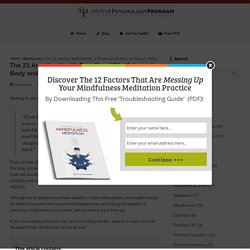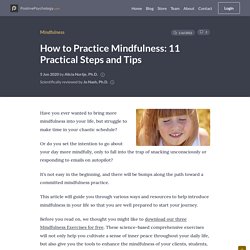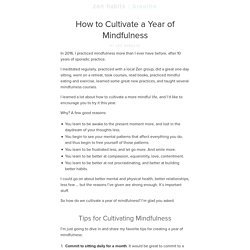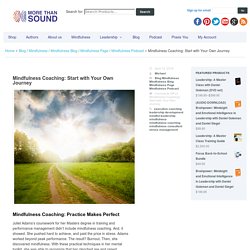

The brain loves to chunk information in order to remember things and there are so many great acronyms that help us remember to bring mindfulness into our lives.

I’m going to list a few really key ones and then link you to respective guided practices or posts as a reference to play with them and bring them into your life. Finally, I’m going to introduce you to a new powerful acronym that gets to the point of mindfulness. STOP (Stop, Take a breath, Observe your experience and Proceed) This is an all time favorite. On YouTube the recording that I created for A Mindfulness-Based Stress Reduction Workbook has almost 80,000 views because the acronym makes sense and it really helps us pause into the moment and open up to what matters. RAIN (Recognize, Allow, Inquire, Non-identify/Natural Awareness) This acronym created by Michelle McDonald and popularized and adapted by Tara Brach, is incredible for helping us gain perspective, self-compassion and confidence with our difficult feelings.
What Is Mindfulness? Definition + Benefits (Incl. Psychology) The 23 Amazing Health Benefits of Mindfulness for Body and Brain (+ PDFs) Home » Mindfulness » The 23 Amazing Health Benefits of Mindfulness for Body and Brain (+ PDFs) “If you truly want to change your life you must first change your mind.”

If you’ve been following this blog, you know that there are countless ways to apply mindfulness in your everyday life. You have probably also noticed that there are tons of benefits of practicing mindfulness regularly. Although we’ve talked about these benefits in a few other places, we thought it would be helpful to provide one resource that breaks down all of the great benefits of practicing mindfulness in one place, with sources to back them up. If you’re wondering what you can get out of being mindful, read on to learn about all the great things mindfulness can do for you! Free Mindfulness Meditation Troubleshooting Guide (PDF) "Find Out What Is Preventing You And Your Clients From Meditating Effectively" Mindfulness and Positive Psychology: A Look at the Benefits and Links. Face It, Accept It, Deal With It, Let It Go.
Minding the details of mind wandering. It’s long been associated with failing grades and accidents behind the wheel, but it turns out that the wandering mind may be far more complex than many believe.

A new article by Paul Seli, a postdoctoral fellow working in the lab of Dan Schacter, the William R. Kenan Jr. Professor of Psychology, examines variations in mind wandering. In the article, Seli and colleagues argue that mind wandering happens both with and without intention, noting important differences between the two in terms of causes and consequences. The research pointing to this conclusion is outlined in a paper in Trends in Cognitive Sciences. Researchers first began examining mind wandering — or “task-unrelated images and thoughts” — in the late 1970s. “Over the years, a number of different constructs have been unified under the single term ‘mind wandering,’ and through that process, the distinction between intentional and unintentional types was lost,” said Seli. All it takes is 10 mindful minutes [ TED Talk : Andy Puddicombe ]
Has Mindfulness Gone Too Far? The rise of mindfulness has been incredible.

In part it seems like many of us are responding to a radical fast pace of living where we’re in a constant state of doing, doing and doing some more and longing for something to help us create balance in our lives. The answer has been a variety of mindfulness programs that place a heavy emphasis of “being” to balance out the “doing.” Mindfulness is a fundamental skill for anyone in this day and age and yet at the same time it can go too far. In the formal practices of mindfulness we do meditative exercises like breathing meditation, the body scan, or an open awareness practice.
All of these focus on training the brain to “be with” experience. This juggle between the past and future only adds stress to our mind and body. Sometimes this state of balance teaches us important lessons, like in life all things come and go, otherwise known as the law of impermanence. But the reality, “being with” something isn’t often enough or even the best response. 7 Myths About Mindfulness (and What You Need to Know) History of Mindfulness: From East to West and From Religion to Science. Here at the Positive Psychology Program, we have been discussing several different aspects of mindfulness for the past few weeks.

In particular, we have explored various ways to learn about mindfulness, practice it, and even where to study the art of teaching mindfulness to others. But where did mindfulness come from, and why have so many people in the West recently become interested in it? There is no easy answer to this question, but one solution is to trace the lineage of mindfulness from early Eastern religions to its modern, secular presence in Western science. This article will cover mindfulness, its roots in Hinduism and Buddhism, how it relates to yoga, and how it came to be popular in so many circles in the Western world.
Finally, we will discuss the most relevant aspect of mindfulness for our purposes, which is how it fits in to the field of positive psychology. Free Mindfulness Meditation Troubleshooting Guide (PDF) Yes, please send me this guide.
Life Satisfaction. Acceptance. Meditation of Action. Selective Focus. Self-Awareness. Meditation. Mindful Living Tools. How To Practice Mindfulness: 10 Practical Steps and Tips. Developing a mindfulness practice has been proven to offer a myriad of positive benefits for the body, mind, and soul.

(Davis & Hayes, 2011). But sometimes, it’s easier said than done. Have you ever wanted to bring more mindfulness into your life, but struggle to make time in between your chaotic schedule? Or set the intention to go about your day more mindfully, only to fall into the trap of snacking unconsciously or responding to emails on autopilot? It’s not easy in the beginning and there will always be some bumps on your path toward a committed mindfulness practice.
This article will guide you through the various ways and resources to help introduce mindfulness in your life so that you are well prepared to start your journey. How to Cultivate a Year of Mindfulness. By Leo Babauta In 2016, I practiced mindfulness more than I ever have before, after 10 years of sporadic practice.

I meditated regularly, practiced with a local Zen group, did a great one-day sitting, went on a retreat, took courses, read books, practiced mindful eating and exercise, learned some great new practices, and taught several mindfulness courses. I learned a lot about how to cultivate a more mindful life, and I’d like to encourage you to try it this year. Why? A few good reasons: Mindfulness Coaching: Start with Your Own Journey. Mindfulness Coaching: Practice Makes Perfect Juliet Adams’s coursework for her Masters degree in training and performance management didn’t include mindfulness coaching.

Blogs. Self-Consciousness. Regulation Strategies. Get one's strength back. Reduce Chronic Pain. Cultivating Mindfulness for Everyday Life.